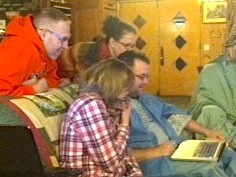Invite Your Students to Create, Compose and Connect
by Jeremy Hyler & Troy Hicks
Even before technology became embedded in the Common Core State Standards, teachers were being asked to make use of the Internet by having students do writing activities using different tools and modalities.

Jeremy Hyler
Thoughtful technology integration, however, is no longer about just using a word processor or having students create a slide presentation at the end of a research project.
In a January rant at Blogging Through the Fourth Dimension, Wisconsin fifth grade teacher Pernille Ripp chose a great title for her post: “It Is Not About the Gadgets – Why Every Teacher Should Have to Integrate Tech Into Their Classroom.”

Troy Hicks
We agree 100%. As English teachers ourselves, we’ve been using digital tools to support literacy instruction for some years now. We’ve shared much of what we’ve learned in a new book we wrote together, Create, Compose, Connect: Reading and Writing with Digital Tools, and we wanted to provide you with a quick glimpse into some of our thinking.
Student-driven learning
We argue that technology is not just about making a lesson engaging; it’s about helping students become effective creators and consumers of information in today’s fast-paced world. Today’s students know how the tools work, but they need us to help maximize technology’s learning potential.

► To start, it may be beneficial to take a survey with your students and parents to find out what type of devices and access your students have. Tools like Survey Monkey or Google Forms can make your surveys paperless and help you compile information more easily.
For instance, Jeremy has developed a technology survey using Google Forms that he shares with 7th grade parents and guardians in the spring, before their student enters middle school. If parents aren’t able to attend the meeting, Jeremy simply posts the survey on his school webpage for parents to access.
When parents are done with the survey, Jeremy can access the results of the survey through a spreadsheet and in addition can easily view them in graphs as well.
► As students begin to show some appetite for using school laptops and their own devices in smart ways, Jeremy introduces web-based platforms like Schoology and Celly. These tools can be used in a variety of ways, including hosting student led discussions; digital literature circles; or simply to send out reminders to students to complete future assignments.
More about Schoology
Schoology is a social media site designed with educators in mind that emulates Facebook (we explain in detail in Chapter 2). Jeremy uses Schoology for two main purposes: to provide resources for students, and to have online conversations about books, articles or pieces of writing. Below are the guidelines and an excerpt taken from a student led conversation. The guidelines are adapted for middle school use, but could be changed for high school and elementary levels.
Using Schoology helps Jeremy to create a virtual community where students ultimately feel more comfortable to share their thoughts because they don’t have to raise their hands and feel embarrassed in front of their peers.
Furthermore, students are leading the discussion and Jeremy doesn’t have to be in front of the classroom always directing the conversation. Instead, he can monitor the discussion taking place online and actively participate with his students instead of his prompting students to answer questions all the time.
These are just a few ideas from work we are doing ourselves. We hope our book can help with more. You can get a better sense of what you’ll find there from these chapter titles:
- Building a Classroom (and Virtual) Community
- The Rest of the Story: Reading and Writing Narratives
- Reading Our World, Writing Our Future (Informational)
- Looking for Evidence (Argumentative)
- Can You Hear Me Now? (Speaking and Listening)
- Seeing Isn’t Always Believing (Visual Literacy)
- Our Many Voices (Multigenre Research Project)
You can also join us in a conversation at the Create Compose Connect blog and view many of our resources on our wiki.
Technology use is no longer a choice. Our students are indeed more familiar with technology at times than we are, but we are the experts on learning. It is time for every educator to take the digital plunge, not just to engage our students but to help them maximize the potential of technology to deepen their learning. We need to be experts about that, too.
Jeremy Hyler (@jeremybballer) is a 7th and 8th grade middle school language arts teacher in Middleton, Michigan, a department co-chair, and a teacher consultant to the National Writing Project. He blogs at jeremyhyler40.
Troy Hicks (@hickstro) is a former middle grades teacher, now associate professor of English at Central Michigan University where he focuses his work on the teaching of writing, literacy and technology. He blogs at Digital Writing/Digital Teaching.




































I am looking forward to the book. Thanks for sharing us a sample of your thinking.
Kevin